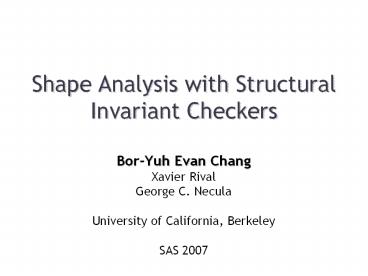Shape Analysis with Structural Invariant Checkers PowerPoint PPT Presentation
Title: Shape Analysis with Structural Invariant Checkers
1
Shape Analysis with Structural Invariant Checkers
- Bor-Yuh Evan Chang
- Xavier Rival
- George C. Necula
- University of California, Berkeley
- SAS 2007
2
Example Typestate with shape analysis
Concrete Example
Abstraction
- cur l
- while (cur ! null)
- assert(cur is red)
- make_purple(cur)
- cur cur!next
program-specific predicate
heap abstraction flow-sensitive
- make_purple() could be
- lock()
- free()
- open()
3
Shape analysis is not yet practical
Usability Choosing the heap abstraction difficult
- Built-in high-level predicates
- - Hard to extend
- No additional user effort
Parametric in low-level, analyzer-oriented
predicates Very general and expressive - Hard
for non-expert
Parametric in high-level, developer-oriented
predicates Extensible Easier for developers
4
Shape analysis is not yet practical
Scalability Finding right level of abstraction
difficult
Ç
Ç
Ç
Ç
Ç
emp
Ç
Ç
Ç
5
Hypothesis
The developer can describe the memory in a
compact manner at an abstraction level sufficient
for the properties of interest (at least
informally).
- Good abstraction is program-specific
6
Observation
Checking code expresses a shape invariant and an
intended usage pattern.
- bool redlist(List l)
- if (l null)
- return true
- else
- return
- l!color red
- redlist(l!next)
7
Proposal
An automated shape analysis with a memory
abstraction based on invariant checkers.
bool redlist(List l) if (l null)
return true else return l!color
red redlist(l!next)
checkers
- Extensible
- Abstraction based on the developer-supplied
checkers - Targeted for Usability
- Code-like global specification, local invariant
inference - Targeted for Scalability
- Based on the hypothesis
8
Outline
- Memory abstraction
- Restrictions on checkers
- Challenge Intermediate invariants
- Analysis algorithm
- Strong updates
- Challenge Ensuring termination
- Experimental results
9
Abstract memory using checkers
Some number of points-to edges that satisfies
checker c
Graphs
values (address or null)
checker run
points-to relation (memory cell)
partial run
Example
Disjointly, !next , !next , and is a
list.
next
list
next
10
Checkers as inductive definitions
bool list(List l) if (l null) return
true else return list(l!next)
Disjointness Checker run can dereference any
object field only once
11
What can a checker do?
- In this talk, a checker
- is a pure, recursive function
- dereferences any object field only once during a
run - only one argument can be dereferenced (traversal
arg)
Traversal argument
bool skip1(Skip l) if (l null) return
true else Skip s l!skip return skip0
(l!next,s) skip1(s)
9,.
Ç
Only fields from traversal argument
12
back to the abstract domain
13
Challenge Intermediate invariants
assert(redlist(l)) cur l while (cur ! null)
make_purple(cur) cur cur!next assert(p
urplelist(l))
Prefix Segment Described by ?
Suffix Described by checkers
14
Prefix segments as partial checker runs
Abstraction
Checker Run
15
Outline
- Memory abstraction
- Restrictions on checkers
- Challenge Intermediate invariants
- Analysis algorithm
- Strong updates
- Challenge Ensuring termination
- Experimental results
16
Flow function Unfold and update edges
x!next x!next!next
Unfold inductive definition
Strong updates using disjointness of regions
17
Challenge Termination and precision
last l cur l!next while (cur ! null) //
cur, last if () last cur cur cur!
next
Observation Previous iterates are less unfolded
Fold into checker edges But where and how much?
18
History-guided folding
last l cur l!next while (cur ! null) if
() last cur cur cur! next
- Match edges to identify where to fold
- Apply local folding rules
l, last
cur
l,
r
last
cur
l
v
?
l
last
?
Yes
l
last
cur
19
SummaryEnabling checker-based shape analysis
- Built-in disjointness of memory regions
- As in separation logic
- Checkers read any object field only once in a run
- Generalized segment abstraction
- Based on partial checker runs
- Generalized folding into inductive predicates
- Based on iteration history (i.e., a widening
operator)
20
Outline
- Memory abstraction
- Restrictions on checkers
- Challenge Intermediate invariants
- Analysis algorithm
- Strong updates
- Challenge Ensuring termination
- Experimental results
21
Experimental results
- Verified structural invariants as given by
checkers are preserved across data structure
manipulation - Limitations (in scull driver)
- Arrays not handled (rewrote as linked list), char
arrays ignored - Promising as far as number of disjuncts
22
Conclusion
- Invariant checkers can form the basis of a memory
abstraction that - Is easily extensible on a per-program basis
- Expresses developer intent
- Critical for usability
- Prerequisite for scalability
- Start with usability
- Work towards expressivity
23
(No Transcript)

